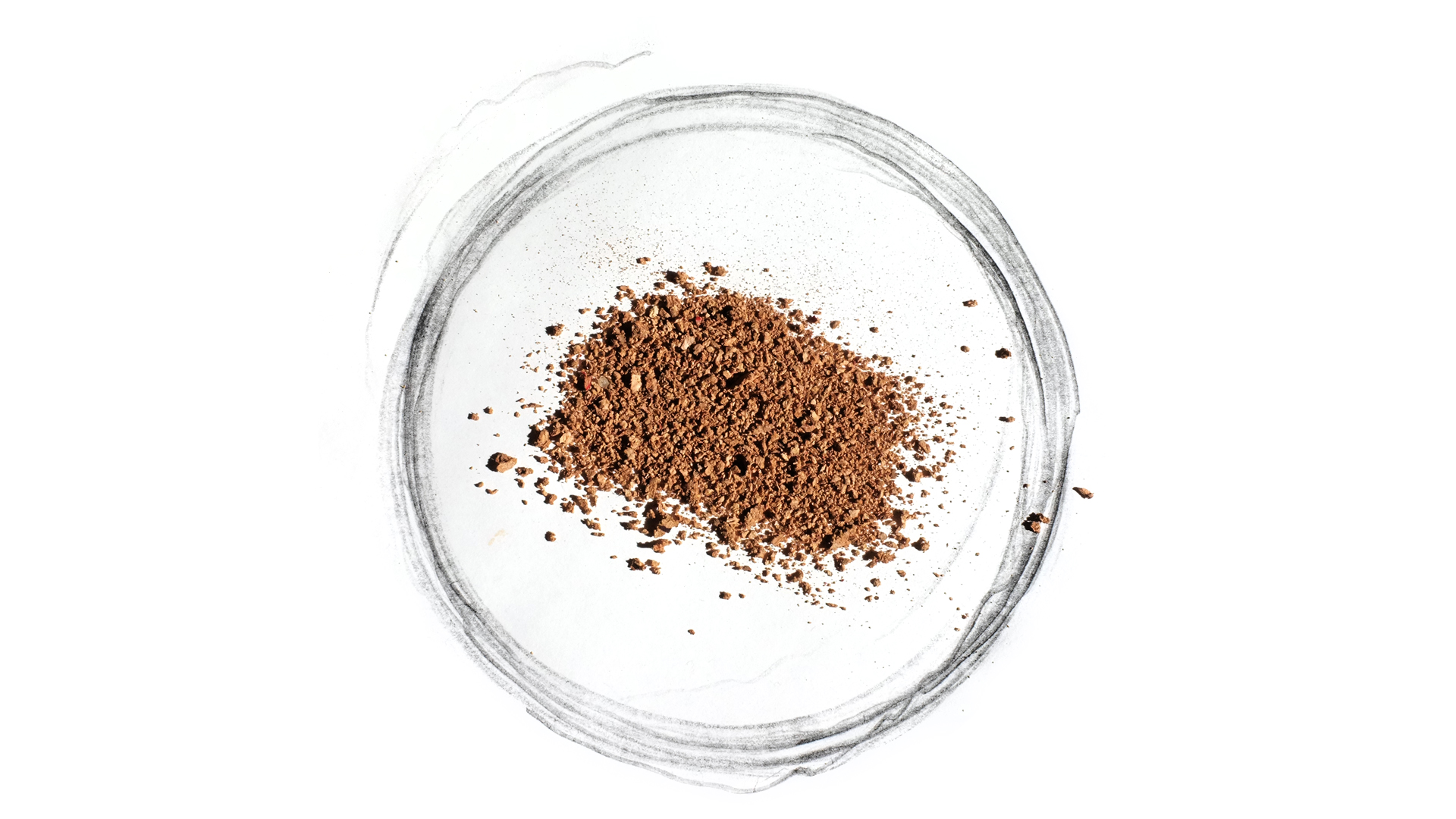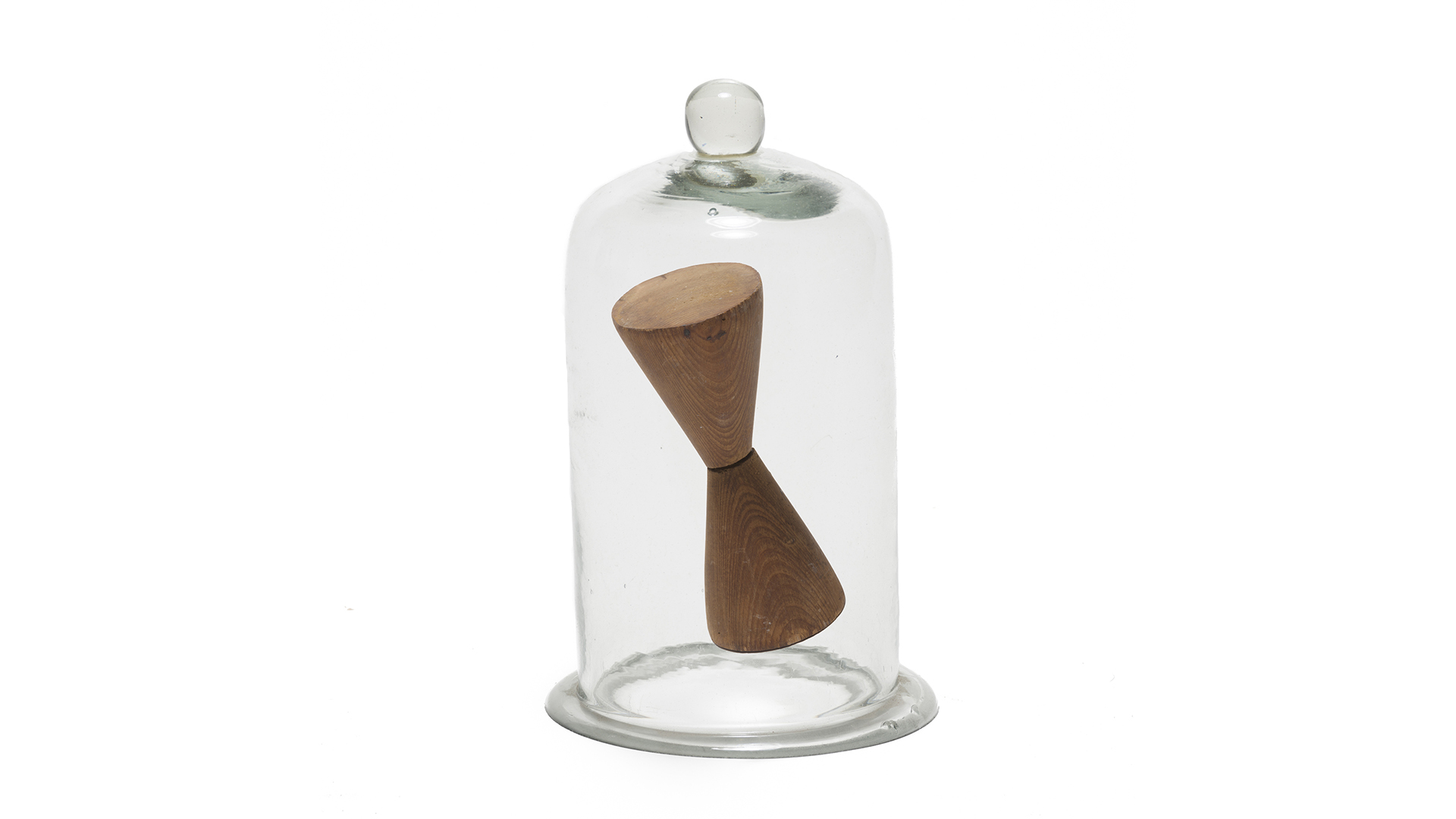Lightyears:
Exploded/Collapsed Auditions for Test Audiences and Technics
2023
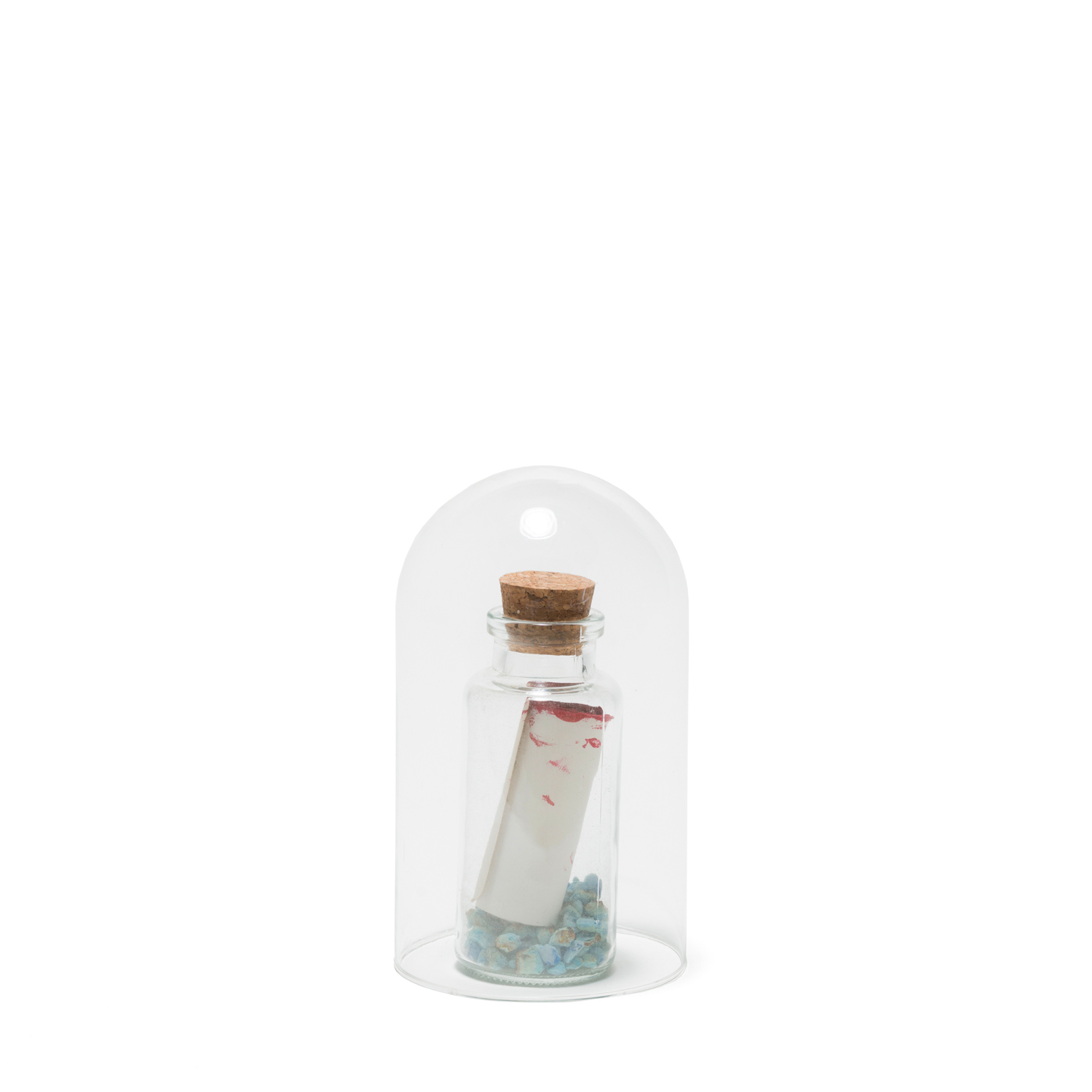
Coppice paper scroll used as stamp with red paint (in 2014), and burnt copper sulfate crystals (in 2017), kept in a glass bottle and displayed in a glass bell jar (in 2018).
Navigation
In introducing his philosophy of technology, with focus on human-technology relations, postphenomenologist Don Ihde describes philosophy’s dual function to provide ”a perspective from which to view” a particular “terrain,” and “a framework or “paradigm” for understanding.”¹
“[P]art of that attainment of perspective,” Ihde writes, “calls for the right amount of distance, such that the uniqueness and even peculiarity of our technological culture could be seen. For insofar as critical thinking is like seeing, both that which is too close (the tip of our nose) and that which is too far (beyond the horizon) are simply not clearly discernible.”² He continues:
The usual or dominant perspective philosophers frequently choose might be called Lucretian. In his classic De Rerum Natura, Lucretius describes the philosophical perspective as one from a high (and, in some translations, “ivory”) tower, from which the woes and movements of humans appear as distant and trivial, like the domain of ants to the standing human. In this distancing — long a metaphor for objectivity — is betrayed preference for a position both fixed and distant. In a contemporary analogue, we might choose a satellite view. Just as today we have bugs to take “whole earth measurements: via satellite, so the philosopher might prefer this high distance.
Yet in this case of the examination of technological culture, there is something radically wrong with such a choice. No more than we can to take a pretended Martian view of ourselves can we escape a certain hidden closeness by the satellite metaphor. To the contrary, inhabiting the satellite would better illustrate precisely the enmeshment, the enclosure we have in our technosphere. The space vehicle is but one extreme example of a technological cocoon that must provide us with life support, a constructed environment, and the enclosed layer by and through which we would be taking our sightings. Far from giving us distance upon the phenomenon, we end by simply taking it for granted.
For that reason, and others to be indicated later, I prefer to take a more Kierkegaardian metaphor as the starting point for establishing a perspective. In Fear and Trembling, in the context of describing the inescapability of decision, Kierkegaard pictures us as captains of ships at sea, under way. The person at the wheel is already in motion; and to come about or not to come about is equally to make a decision. I shall modify this image by noting that the position of this perspective is basically navigational. The navigator, in the very midst of the sea where both boat and sea are in motion, must take bearings, find a direction, and locate both himself and his destination. This perspective occurs in a dynamic and fluid situation and is necessarily relativistic, yet just such a situation is normal for the navigator.
The navigational perspective is quite self-consciously aware of being in the midst of what is occurring, but the navigational problem is to locate reference positions through some means of variations. Here there is at least one good lesson that can be learned from space travel as well. Astronauts living in the various cocoons we have devised find themselves weightless. Their earthbound reference point, gravity relating to our normally upright posture, was missing. They had to choose a reference point from which to move. Frequently they would do this arbitrarily: “That knob there will mean ‘up,’ and that lever there, ‘down.'” In short, they had to relearn a kind of bodily motility in a new frame of reference, and thus they invented a new kind of bodily navigation. Similarly, in the various styles of navigation, some means of referencing and some set of variations have to be established to attain the relativistic locations crucial for finding our way about.³
Opening
Coppice was founded by Noé Cuéllar and Joseph Kramer in Chicago in 2009, as an inquiry into the capture and generation of music and its relationship to its physical sources. Its compound studies include Bellows & Electronics (prepared pump organs, shruti boxes, and tape processors) between 2009–2014, and Physical Modeling & Modular Syntheses between 2014–2018; focusing on the interactions between direct and reproduced sound, and the perceptual links between original and emulated sources, respectively.
Its third study in Phonography & Fiction (2018-2022) scrutinizes the dynamics between its previous two studies, and their relationship to architecture and time: the acoustic preservation and obsolescence of the Yerkes Observatory’s refractor and reflector telescopes in Williams Bay being the locus of investigation.
With sustained interest in sound’s capacity to cross domains, Coppice crafts pathways between music and technology in a cross-disciplinary language, resulting in work that is an overarching documentation of experimental music in-formation. Operating in cycles of instrument construction and modification, recordings, and live presentations, its productions incorporate sound design, sculpture, installation, software, images, and video.
Refraction, Reflection, and Diffusion
Having investigated interests in obsolescence and preservation toward instruments and devices since 2009, Coppice transposed such investigation to a larger physical scale in documenting the acoustic characteristics of the Yerkes Observatory in Williams Bay, Wisconsin, during its temporary closing in 2018. Using the observatory as an instrument, mechanically and architecturally (not dissimilar to mechanical pump organs or tape machines, being pneumatic and rotational), Coppice composed several works that narrate that shift in scale from instruments to spaces in an overarching experimental music process. The audio paper Stewardship to Obsolescence and Preservation: Listening to Specimen Music through Yerkes Observatory’s Refractor and Reflector Telescopes (2021) conceptually questions the criss-crossing of documentary and fiction in regard to memory and actuality on a par with technological perspectives.
Founded in 1892, the Yerkes Observatory houses two reflector telescopes and the largest refractor telescope in the world. Refraction and reflection are descriptors used by Coppice to convey its first two studies, corresponding to the ‘refraction’ of signal processing and tape delay effects characteristic to its study of Bellows & Electronics, and to the ‘reflection’ of sound simulations and sound designs centered on analog and digital syntheses in its second study. Building upon these analogies of refraction and reflection, Coppice’s third study in Phonography and Fiction is ascribed ‘diffusion’ given its turning of attention away from instruments, and instead toward devices of capture and reproduction, and their relation to the spaces in which they operate. As do telescopes’ peering into a night sky, this third study stands as a ‘lens’ through which a ‘sonic observation’ of Coppice’s musical past can take hold: so is the premise of the audio paper.
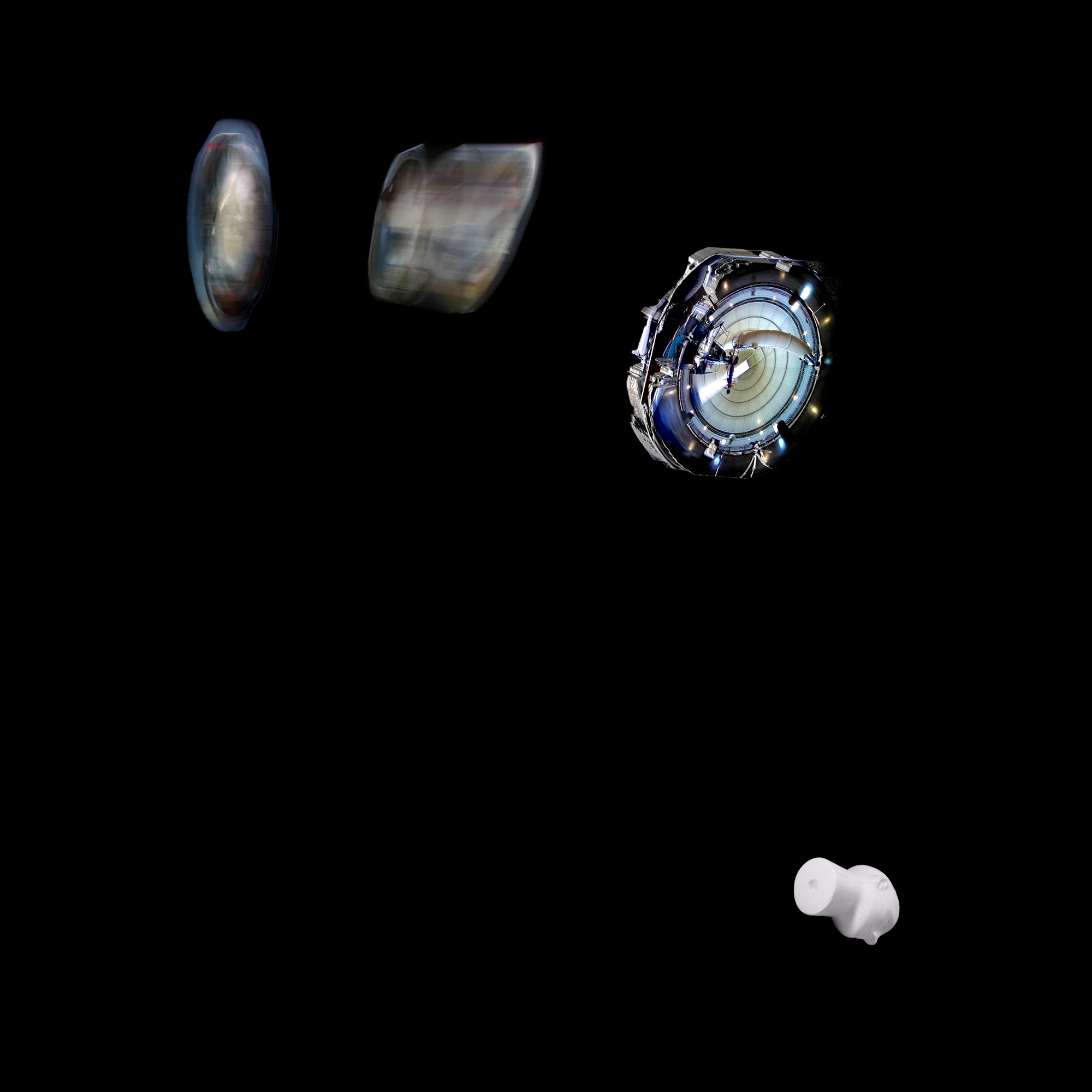
Coppice’s artwork for the audio paper Stewardship to Obsolescence and Preservation: Listening to Specimen Music through Yerkes Observatory’s Refractor and Reflector Telescopes (2021). The image includes volumetric images of Yerkes’ rooms in motion.
In summary, Coppice’s glossary of study thus far is identified as follows:
2014-2018
2018-2022
Physical Modeling & Modular Syntheses
Phonography & Fiction
Refraction, Reflection, and Diffusion are used as metaphorical shorthand to describe each study, by way of ‘the observatory’ as a structure through which grasp Coppice’s overarching musical experiment. In light of Diffusion, Coppice proposes a ‘sonic observation’ of such experiment through a juxtaposition and manipulation of each study’s timelines.
Temporal Composition: Abridging
From the perspective of its third study in Phonography & Fiction, which is characterized by processes of documentary and documentation, Coppice abridges its first two studies by re-composing short pieces out of audio quotations from each. The sonic palette specific to each study is conveyed in just under 7 minutes: Circumpass (2013) representing Bellows & Electronics, and Compass (2018) representing Physical Modeling & Modular Syntheses.
Representing Phonography & Fiction, Hourglass (2022) abridges Coppice’s overarching sonic palette across all three studies, 13 years of work conveyed in the duration of one hour, using the same montage techniques that make up Circumpass and Compass.
While Circumpass is composed of audio samples from the study in Bellows & Electronics, Compass samples not only audio, but the software instruments used in the Physical Modeling & Modular Syntheses study. In order of appearance (with overlaps), Circumpass features quotations from:
-
- Prune (2011)
- Vinculum (Courses) (2011)
- Discharge Form (2012-2015)
- Bramble (2012-2015)
- An Instance of Agate/Bluing (2012)
- Vinculum T-CP 01.01 007:07 (2009-2013)
- Vinculum PC-1 04.02 000:22 (2009-2012)
- While Like Teem or Bloom Comes (Tipping) (2012-2015)
- Pivot (2011-2014)
- IX. Low F Phase & Chorus (2011-2014)
Instrumentation includes Modified Boombox, Free Reed Boxes, Prepared Pump Organ (Kinder), Prepared Shruti Box (Orange), Apiary, Sphygmomanometer, Accordions, Acoustic Filters, Electronics, and Tape Processes.
In order of appearance (with overlaps), Compass features software instruments (*) and quotations from:
-
- Surveillance (2016-2018)
- Flut (Tighter) (2014-2016)
- Burning Message/Message Burning (2015-2017)
- Wet Hologram (2016-2018)*
- Afterthought (2016-2018)*
- Fake Memories Object (2018)*
- Country Road (2016-2018)*
- Ashdown (2016-2018)*
- Coverage (2018)*
Instrumentation includes Physical Modeling Synthesis, Modular Synthesis, Wurlitzer 200A Electric Piano (and emulator), Fender Rhodes amp (and emulator), Copper Plate, Tape Case, Transmitters, Inductive Mixing Table I, Coils, Fans, Motors, and Magnetically-Permeable Sheet, and Convolution Effects.
Following the metaphorical scheme of observatory sound, Hourglass represents the sonic observation of Coppice’s first three studies in a series of conjunctions (juxtaposed samples), as would be the observation of celestial motions and events, with transits (single-occurrence samples), orbiting objects (samples spaced out in time), evoking an overall sense of high speed traversal of space, space, and sound. In order of appearance (with many overlaps), Hourglass features audio quotations from many works including previously discarded or unreleased audio:
(Dispersed)
Discharge Form
Flut (Tighter)
2012-2015
2014-2016
☌ Fake Air Storage
2016-2020
Index Transfer Outtakes from “Epoxy”
Extracts of “Studies for Three Somewheres”
Excerpts from rehearsals
Fake Air Song (unreleased)
Excerpt from Country Road (Alternate)
Excerpts from The Blessing of No Images
2013
2013
2013
2018
2017
2017
☌ Induction and Bifurcation
☌ Bromine
☌ Brim
2014-2016
2012-2015
2009-2012
☌ Dense Day Cooling (Dorsal)
2016-2018
Extracts of “Studies for Three Somewheres”
2013
☌ Emanations
2015-2018
☌ Whiting Belt: Territorial Scan
☌ Whiting Belt: Scanned Exit
☌ whirling music by Billie Holiday/The Shadows
2014-2016
2014-2016
2018
(Extracts, Scraps,
and Excerpts)
Extracts from Blueberry
Extracts from Droopy
Extracts from Ground
2016
2013
2016-2018
☌ extract from Here
2016-2018
At the Poles is a shorter work that juxtaposes unaltered solo performances for prepared pump organ (an Estey performed by Noé Cuéllar in January 2013) and modular syntheses (performed by Joseph Kramer in May 2016), each of which has been previously heard integrated in Soft Crown (from 2014’s Vantage/Cordoned and Soft Crown Transparencies), and Here (from 2018’s Green Flame).
Nested Diffusions: Framing Situations and Emplacements
Having been composed as recordings (and not performances), these three abridgments are then used to demonstrate different auditory diffusions: in simulated (synthesized) space based on the acoustics of the Yerkes Observatory (Compass and Circumpass nested in Observatory Sound), and in situ through Chicago Laboratory for Electro-Acoustic Theatre (CLEAT), a multi-channel audio array as binaurally documented at Elastic Arts in Chicago (Hourglass nested in Sonic Observation). In this way, a mise en abyme or picture-within-picture effect is rendered audible, to contemplate the shapeshifting identities of the experimental music process over time, as ‘framed’ by and nested within spaces.
While the dilemma of an inherent lack of delimiting frames in the auditory dimension is explored more fully in the audio paper, Coppice’s interest in devising speculative frames is explored through these various spatial composition techniques, which yield invitations for a listener to perceive simulation and actuality.
Philosopher of technology Marshall McLuhan writes:
[a]uditory space has no boundaries in the visual sense. The distance a sound can be heard is dictated more by its intensity than by the capacity of the ear. We might compare this to looking at a star, where visual sensation, transcending the vanishing point, is achieved, but at the sacrifice of the precise framework we call visual space. There is nothing in auditory space corresponding to the vanishing point in visual perspective.⁴
Considering film and sound theorist Michel Chion’s pointing out of the lack of a ‘sonic frame’ that delimits sounds, and McLuhan’s impossibility of an ‘acoustic horizon,’ Coppice engages with notions of fiction to propose its own. This is done through technological techniques in spatial composition including both the ‘actual’ diffusion of sound in real spaces, and the simulated diffusion of sound in virtual spaces. Presented as a polarity, a flux of auditions between actual and simulated diffusions are for Coppice necessary to demonstrate imaginative speculations on sonic framing possibilities.
Operations in Spatial Compositions: Exploded and Collapsed
Broadly speaking, Coppice’s work is also characterized by oscillations between ‘exploded’ and ‘collapsed’ auditions. What is meant by exploded is that sound occurs in different points in an actual space where listeners also find themselves, in situ, amid sound installations with various degrees of performance and unmanning. Collapsed refers to the audition of a technological auditory perspective (most often stereophony) of the original ‘explosions’ of sound in a space. Such ‘collapsing’ entails several transformations of sound that are compositionally considered, so that they in turn correspond to auditory transformations in a listener. Such transformations afford a portable and repeated listening that may be private and prone to ongoing recontextualization.
Coppice’s early operations, that is, negotiations between spatial events and their technological capture, usually begin as spatial compositions (such as performed sound installations or staged performances) that are then compositionally adapted into stereo productions (and not simply recorded). The following overview exemplifies works that were first conceived as exploded, spatialized multi-loudspeaker events, and were then collapsed or adapted into stereo productions that are not mere documentations:
Vinculum (Courses) (2011)
Mortar, Snow, and Brim (2011)
Vinculum (Coincidence) (2011)
Bypass (2014)
Soft Crown Transparencies (2014)
live performances in 2014-2015
Vinculum (Courses) (2011)
Spans: Three Perspectival Accounts (2015)
Vinculum (Coincidence): Indexed Conjectures Of Coincidence Imprints Once Happened (2014)
Bypass Ideal (2014)
Soft Crown (2014)
Open on Occluded Conditions (2017)
The reverse was explored in Coppice’s 2016 Turning Concert, in which full recordings were reproduced, in addition to the performance of live instruments, across multiple speakers of various types scattered throughout a performance space that remained ‘exploded’ without an auditory sweet spot, as it was intersected by listeners in motion: an event that did not collapse.
This tendency of working in exploded and collapsed forms recurs in Coppice’s sonic documentation of Yerkes Observatory’s mechanics: the observatory’s large-scale architectural and mechanical features ‘reduce’ to their stereo representation in the audio paper. In it, the acoustics of the Yerkes Observatory are heard as recorded, but also as simulated: turned into a spatial-auditory plane of representation into which is inserted quotations (‘specimens’) of Coppice’s music, as to simulate the verberation of Coppice’s music inside of Yerkes. Combined, the representation of actual acoustics, and simulated acoustics, may appear indistinguishable.
The simulations of Yerkes’ acoustics were created by Coppice on site in 2018, over 120 years since Yerkes was founded. Those models or ‘impulse responses’ are used to simulate the diffusion of Compass and Circumpass, each corresponding with Yerkes’ two architectural wings, which respectively house refractor and reflector telescopes. Rotations in Refractor (2021) and Turning in Reflectors (2021) explore this kind of spatial synthesis. Together as Observatory Sound (2021), these works are a two-way figuration: Yerkes’ structure as a physical representation of Coppice’s experiments, and Coppice’s experiments as a musical representation of Yerkes’ structure.

Coppice image for Observatory Sound (2021), including plan of main floor of the Yerkes Observatory (1897) from University of Chicago Photographic Archive, [apf6-00076], Special Collections Research Center, University of Chicago Library.
Recursion and Convolution
So far, Coppice’s techniques in auditory assembling, enframing, and situating have been described. These involve abridgments (through assemblage of quotations), the insertion of these into speculative sonic frames (enframing), and their technological diffusion as spatial compositions (situating). Like auditory nesting dolls, these are then captured in a binaural emplacement. This culminating process in Coppice’s retrospective work displays a convolution of processes that emphasizes a mediative logic, but also rich variegations of auditions offered to a listener.
Because proper vocabulary to describe certain nuances in sound and audition are not common, some wording guides are proposed. For example: the word ‘diffusion’ may refer to the way in which frequencies are affected by acoustic reverberation, as well as to the distribution of sounds across multiple loudspeakers. Because Coppice seeks to bring attention to its production processes, ‘simulated diffusion’ refers to artificial verberation and spatialization alike (in other words, simulated spaces), whereas ‘diffusion’ refers specifically to actual, or ‘real’ spaces. Actuality and simulation co-exist amid their differences and likenesses.
This is of interest in Coppice’s study in Photography & Fiction and at large: the bringing to awareness in a listener the multiple domains that sound and technologies cross in the auditory dimension. In encounter of those crossings, a listener’s audition itself also crosses throughout various auditory awarenesses.
Draw Agreement: a Spatiotemporal Synthesis of Abridgements, Observatory Sound, and Sonic Observation
Coppice’s Sonic Observation is a work composed for CLEAT (Chicago Laboratory for Electroacoustic Theatre), a 16-channel 96-speaker sound system, and 2.1 PA system, to bring focus to auditory experiments in an actual space, Elastic Arts in Chicago, where the CLEAT system is housed. This work balances, on one hand, exploding and collapsing techniques of production, as previously described, and on the other, the technological diffusion of sounds across an actual space. In turn, the documentation of this event is a compositional process involving multiple technological perspectives, including binaural audio in various degrees of freedom and motion, with extra wild sound.
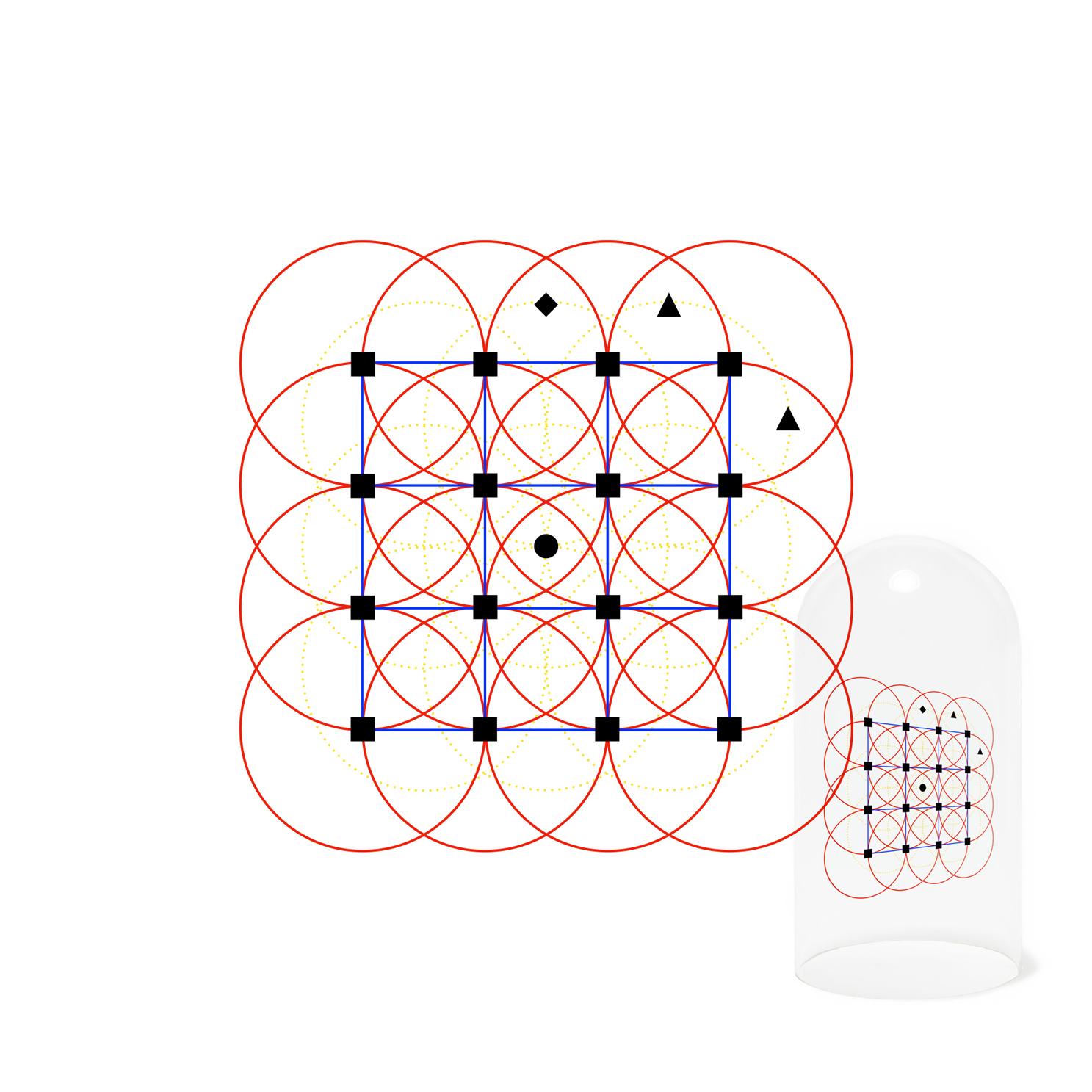
Coppice’s visual representation of the spatial scheme of CLEAT and its binaural capture and elaboration, Sonic Observation (2022).
In turn, the documentation of this event is a compositional process involving multiple technological perspectives (such as multiple forms of binaural audio in various degrees of freedom and motion). Each of these various recording carry their own distinct auditory effects when reproduced. Existing as options, these represent the Sonic Observation event from multiple points of technological audition.
Brought together in the 3CD set Draw Agreement, its Abridgements, Observatory Sound, and Sonic Observation are counterparts to one another in a spatial composition triptych:
- Abridgements (73 minutes) abbreviate Coppice’s three glossaries of study from 2009–2022.
- Observatory Sound (35 minutes) simulates the insertion of Coppice’s first two abridgments (Compass and Circumpass) into the acoustics of the Yerkes Observatory.
- Sonic Observation (60 minutes) is a binaural capture and elaboration of Coppice’s technological diffusion of its third abridgment (Hourglass) using the CLEAT system on-site at Elastic.
While these nested mediations may appear complex, they mirror the ubiquitous and cascading hypermediated realities that make up today’s metamodernist everyday. These works present them in a context inviting of auditory contemplation. As previously mentioned, this effect may be likened to mise en abyme, the placement of a picture-within-a-picture in visual art, or what more immersively may be described as the viewing of a digital rendering of a photograph of a painting through a virtual reality headset (and so on…). This process sets in motion rich subjectivities considering the freedom a listener may have to reproduce these recordings in contexts of their choosing.
The purpose of Draw Agreement is to recapitulate, in a relatively brief amount of timeframe, the shapeshifting identities of Coppice’s sonic characteristics across its studies between 2009-2022. It is a triptych (or together, a shaken snow globe) of an overarching experimental music process and its traces in passing. What this offers a listener is the sensation of a soundspacetime which, despite appearing linearly, may also be grasped multi-dimensionally in its cross-relations and flux of auditions. As the vanishing point itself, a listener may engage multiple auditions and auditory perspectives while traversing the actual and simulated movements of a musical idea.
In the audio paper, Coppice uses metaphoric and poetic language to describe its preservation of the acoustics of the Yerkes Observatory, and its use of it as a tool for further experimentation. This includes the notions of observatory sound and sonic observation, which make reference to the acoustic sound belonging to the observatory, and stimulation for a listener to listen inquisitively. Through sonic observation, a listener may tend to the sources of sound, and thus of music: a visionary listening that ‘sees’ sound’s origins as relational between materials, varieties of spaces, technologies, as well as musical ideas and imagination.
Considering the concepts in 20th century experimental and avant-garde music, that listening in itself is an act of composing (Cage, Oliveros, Lucier, among others), Coppice seeks to emplace a listener amid energies and motions of an exploded music across domains, actual and simulated spheres of sound, and technologies. To guide such experiences, the metaphors of sonic observation and observatory sound, and the refractive and reflective telescopic, are used to evoke the vastness of a musical cosmology out of which subjective constellations may be made. Coppice pertains not only to the musical ‘content’ or sounds heard, but also to the manners in which technological options relate to that subject matter in its production, and in its reproduction phases.
As a temporal art, the listener reconfigures ephemeral puzzles in their pastime. Considering cultures’ visuo-centricity, visual metaphor may help grasp the depths of auditory experimentation and its ‘outer space.’ Keeping visuals at a minimum, and always with the intention of auditory support when viewed, Coppice works address ‘the ear’ (and ‘the mind’s ear’) to tell imagination where to go.
Telescopes and Clocks: Summation of Technics to Crossing Domains
Draw Agreement balances Coppice’s strategies in spatial composition by calling to attention superimpositions of what is actual and what is simulated, whether these are distinguished between or not. Having created its own impulse responses on-site at the Yerkes Observatory, the simulated acoustics of that site have become an instrument and an effect alike, through which Coppice’s abridgments can be heard. Also approached as a sonic frame, Elastic’s CLEAT diffuses sound in actual space, and Coppice’s documentation of this in turn introduces auditory convolution that elaborates on facts.

CLEAT’s 16 independent hemispherical channels with 6 mono loudspeakers each in a semi-radial quasi-pentagon arrangement.

Coppice recording the Yerkes Observatory’s Great Refractor and reflector telescopes in Williams Bay, Wisconsin in 2018.
Observatory Sound includes many recordings of the mechanical movements of the Yerkes Observatory’s domes, floors, shutters, and telescopes: what may be thought of as the sounds of alignment and calibration to peer into the cosmic past. Excluding those documented movements, Sonic Observation drifts afloat, representing an hour-long sonic observation of a fragmented music’s revolutions.
These musical experiments offer auditory demonstrations that seek bringing to awareness in a listener the variegated ontologies and placements of sound(s), temporal values, and the logic of technological-mediative processes – inherent parts of a particular musical conception today. Coppice seeks to display not only the multiple ways in which sound and technologies cross domains, but also foment shifts in auditory perspective and awareness.
The Long Distance Realities of Documentation
Approaching the act of documentation compositionally, the capture of the live event at CLEAT consisted of placing a set of binaural ears (simulating the human head) at the center of the space, recording the sphericity of the space for eventual headphone listening. Subverting the alleged fidelity of binaural recording to natural binaurality, however, is a headlock audio composition that has been juxtaposed against that documentation.
Titled Clocks in Flux, this elaborated multi-tiered documentation includes multiple forms of timekeeping and time-stamping, actual and fictional, such as ‘now,’ ’15 seconds,’ and ‘8:43 PM,’ corresponding to the moment of recording, and any other time that the recording may coincide with when reproduced.
The headlock audio included in Clocks in Flux includes sounds additional to what was heard on-site during the CLEAT event. This is a convoluted juxtaposition: binaural audio’s representation of sound as a surrounding (around a listener’s head), and affixed headlock audio’s representation of sound as mental sound or sound lodged ‘inside the head’ (or literally, sound ‘external to the binaural dummy head’).
The three-parts of Draw Agreement probes time in observation of an overarching experimental music process spanning 13 years. In these works, Coppice’s suggestion for a listener is to traverse multiple auditions and auditory illusions, including those of speculative sonic frames through which memory and orientation in today’s increasingly present lens of technology may be audited.
A Time Machinic Future
The word ‘coppice’ defines a wooded area where trees are periodically cut back to stimulate their growth. The practice of coppicing is synonymous with what Coppice in artistic and technical terms describes as the oscillation between exploding and collapsing working techniques. Accretion and excision, reference and consequence, obsolescence and preservation. The marked shift from one study to the next alludes to the cyclical horticultural practice of coppicing.
Draw Agreement brings Coppice’s first three glossaries of study, between 2009-2022 to completion. On the other side, which is already (or was), is a continued exploration of a longstanding pattern of interest in the cross-referencing of objects (sounds, thought forms, technologies, and musical ideas), in their actual and represented conditions: as is and as if.

¹ Ihde, Technology and the Lifeworld, 9.
² Ibid.
³ Ibid., 9-10.
⁴ McLuhan and Carpenter, “Acoustic Space,” 68.
